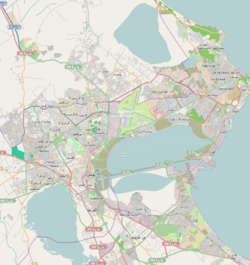
Back قرطاج (بلدية) Arabic Карфаген (ҡала) Bashkir Картаген Bulgarian Cartago (municipi) Catalan Carthage (lungsod sa Tunisia) CEB Карфаген (хула) CV Cartago (municipio) Spanish قرطاج (تونس) Persian Carthage (municipalité) French Cartagine (Tunisia) Italian
Carthage
قرطاج | |
|---|---|
 Partial view of the modern municipality from Amilcar in Sidi Bou Said | |
| Coordinates: 36°51′18″N 10°19′50″E / 36.85500°N 10.33056°E | |
| Country | |
| Governorate | Tunis Governorate |
| Delegation(s) | Carthage |
| Government | |
| • Mayor | Hayet Bayoudh (Tahya Tounes) |
| • Deputy Mayor | Omar Fendri |
| Area | |
• Total | 180 km2 (70 sq mi) |
| Population (2014)[1] | |
• Total | 24,216 |
| • Density | 130/km2 (350/sq mi) |
| Time zone | UTC+01:00 (CET) |
| Website | www |
Carthage (/ˈkɑːrθɪdʒ/ KAR-thij; Arabic: قرطاج, romanized: Qarṭāj) is a commune in Tunis Governorate, Tunisia. It is named for, and includes in its area, the archaeological site of Carthage.
Established in 1919, Carthage is some 15 km to the east-northeast of Tunis, situated between the towns of Sidi Bou Said to the north and Le Kram to the south. It is reached from Tunis by the R23 road via La Goulette, or by the N9 road via Tunis–Carthage International Airport.
The population as of January 2013 was estimated at 21,277,[2] mostly attracting the more wealthy residents.[3] The Carthage Palace (the Tunisian presidential palace) is located on the coast.[4]
Carthage has six train stations of the TGM line between Le Kram and Sidi Bou Said: Carthage Salammbo (named for the ancient children's cemetery where it stands), Carthage Byrsa (named for Byrsa hill), Carthage Dermech (Dermèche), Carthage Hannibal (named for Hannibal), Carthage Présidence (named for the Presidential Palace) and Carthage Amilcar (named for Hamilcar).
- ^ (in French) Population estimate of 2013 Archived 2015-09-24 at the Wayback Machine National Institute of Statistics – Tunisia
- ^ "Statistical Information: Population". National Institute of Statistics – Tunisia. Archived from the original on 24 September 2015. Retrieved 3 January 2014.; up from 15,922 in 2004 ("Population, ménages et logements par unité administrative" (in French). National Institute of Statistics – Tunisia. Archived from the original on 7 December 2013. Retrieved 3 January 2014.)
- ^ David Lambert, Notables des colonies. Une élite de circonstance en Tunisie et au Maroc (1881-1939), éd. Presses universitaires de Rennes, Rennes, 2009, pp. 257-258. (in French) Sophie Bessis, « Défendre Carthage, encore et toujours », Le Courrier de l'Unesco, septembre 1999 Archived 2007-06-13 at the Wayback Machine
- ^ "More Tunisia unrest: Presidential palace gunbattle". philSTAR.com. 17 January 2011. Archived from the original on 8 September 2012. Retrieved 28 October 2011.

